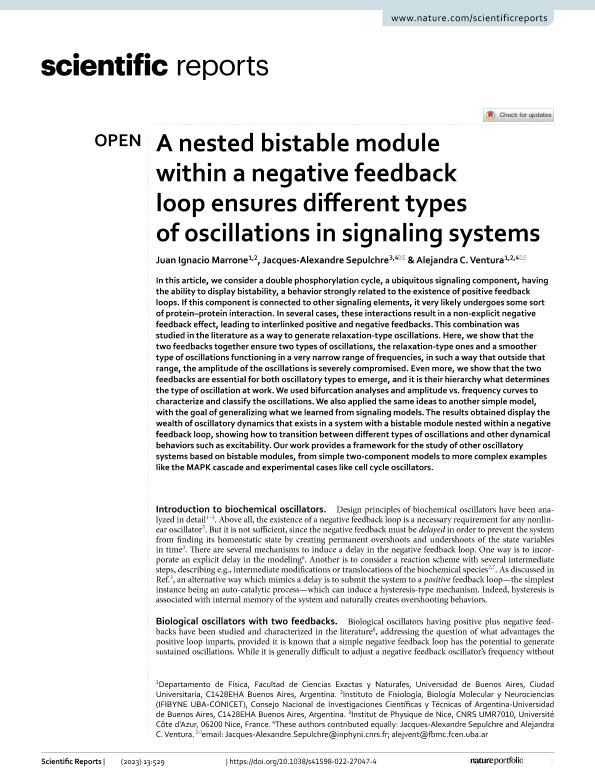Mostrar el registro sencillo del ítem
dc.contributor.author
Marrone, Juan Ignacio

dc.contributor.author
Sepulchre, Jacques Alexandre

dc.contributor.author
Ventura, Alejandra

dc.date.available
2023-11-30T12:47:07Z
dc.date.issued
2023-01
dc.identifier.citation
Marrone, Juan Ignacio; Sepulchre, Jacques Alexandre; Ventura, Alejandra; A nested bistable module within a negative feedback loop ensures different types of oscillations in signaling systems; Nature Research; Scientific Reports; 13; 1; 1-2023; 1-19
dc.identifier.uri
http://hdl.handle.net/11336/218872
dc.description.abstract
In this article, we consider a double phosphorylation cycle, a ubiquitous signaling component, having the ability to display bistability, a behavior strongly related to the existence of positive feedback loops. If this component is connected to other signaling elements, it very likely undergoes some sort of protein–protein interaction. In several cases, these interactions result in a non-explicit negative feedback effect, leading to interlinked positive and negative feedbacks. This combination was studied in the literature as a way to generate relaxation-type oscillations. Here, we show that the two feedbacks together ensure two types of oscillations, the relaxation-type ones and a smoother type of oscillations functioning in a very narrow range of frequencies, in such a way that outside that range, the amplitude of the oscillations is severely compromised. Even more, we show that the two feedbacks are essential for both oscillatory types to emerge, and it is their hierarchy what determines the type of oscillation at work. We used bifurcation analyses and amplitude vs. frequency curves to characterize and classify the oscillations. We also applied the same ideas to another simple model, with the goal of generalizing what we learned from signaling models. The results obtained display the wealth of oscillatory dynamics that exists in a system with a bistable module nested within a negative feedback loop, showing how to transition between different types of oscillations and other dynamical behaviors such as excitability. Our work provides a framework for the study of other oscillatory systems based on bistable modules, from simple two-component models to more complex examples like the MAPK cascade and experimental cases like cell cycle oscillators.
dc.format
application/pdf
dc.language.iso
eng
dc.publisher
Nature Research
dc.rights
info:eu-repo/semantics/openAccess
dc.rights.uri
https://creativecommons.org/licenses/by-nc-sa/2.5/ar/
dc.subject
MULTISTABILITY
dc.subject
OSCILLATORS
dc.subject
NONLINEAR
dc.subject
SYSTEMS
dc.subject.classification
Otras Ciencias Físicas

dc.subject.classification
Ciencias Físicas

dc.subject.classification
CIENCIAS NATURALES Y EXACTAS

dc.subject.classification
Otras Ciencias Biológicas

dc.subject.classification
Ciencias Biológicas

dc.subject.classification
CIENCIAS NATURALES Y EXACTAS

dc.title
A nested bistable module within a negative feedback loop ensures different types of oscillations in signaling systems
dc.type
info:eu-repo/semantics/article
dc.type
info:ar-repo/semantics/artículo
dc.type
info:eu-repo/semantics/publishedVersion
dc.date.updated
2023-11-28T14:43:56Z
dc.identifier.eissn
2045-2322
dc.journal.volume
13
dc.journal.number
1
dc.journal.pagination
1-19
dc.journal.pais
Reino Unido

dc.journal.ciudad
Londres
dc.description.fil
Fil: Marrone, Juan Ignacio. Consejo Nacional de Investigaciones Científicas y Técnicas; Argentina. Universidad de Buenos Aires; Argentina
dc.description.fil
Fil: Sepulchre, Jacques Alexandre. Institut de Physique de Nice; Francia. Centre National de la Recherche Scientifique; Francia
dc.description.fil
Fil: Ventura, Alejandra. Universidad de Buenos Aires; Argentina. Consejo Nacional de Investigaciones Científicas y Técnicas; Argentina
dc.journal.title
Scientific Reports
dc.relation.alternativeid
info:eu-repo/semantics/altIdentifier/url/https://www.nature.com/articles/s41598-022-27047-4
dc.relation.alternativeid
info:eu-repo/semantics/altIdentifier/doi/http://dx.doi.org/10.1038/s41598-022-27047-4
Archivos asociados
